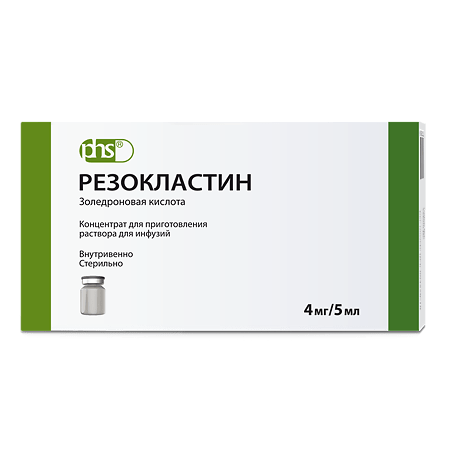No products in the cart.
Resoclastin, 4 mg/5 ml 5 ml
€1.00
Out of stock
(E-mail when Stock is available)
Description
Bone tissue resorption inhibitor, bisphosphonate.
It has a selective effect on the bone. It has an inhibitory effect on bone tissue resorption mediated by osteoclasts.
The selective action of bisphosphonates on bone tissue is based on their high affinity for mineralized bone tissue, but the exact molecular mechanism providing inhibition of osteoclast activity is still unknown.
In addition to its inhibitory effect on bone resorption, zolendronic acid has other antitumor properties that provide therapeutic efficacy in bone metastases.
In vivo: inhibition of osteoclastic bone resorption, changing the bone marrow microenvironment, resulting in reduction of tumor cell growth; anti-angiogenic activity. Suppression of bone resorption is clinically accompanied by a pronounced reduction of pain sensations.
In vitro: inhibition of osteoblast proliferation, direct cytotoxic and pro-apoptotic activity, synergistic cytostatic effect with antitumor drugs; anti-adhesive/invasive activity.
Zoledronic acid, by inhibiting proliferation and inducing apoptosis, has direct antitumor effects against human myeloma cells and breast cancer cells, and also reduces penetration of breast cancer cells through the extracellular matrix, indicating that it has antimetastatic properties.
In addition, zoledronic acid inhibits proliferation of human endothelial cells and in animals causes anti-angiogenic effects.
In patients with tumor-induced hypercalcemia, zoledronic acid has been shown to decrease serum calcium concentration and urinary excretion.
Indications
Indications
Active ingredient
Active ingredient
Composition
Composition
Active ingredient:
zoledronic acid monohydrate;
Excipients:
D-mannitol; sodium citrate dihydrate;
water for injection
How to take, the dosage
How to take, the dosage
Injected by IV drip for 15 minutes.
The recommended dose is 4-8 mg. The frequency of administration depends on the indication, the applied treatment regimen, and therapeutic effectiveness.
Interaction
Interaction
In concomitant use of bisphosphonates and aminoglycosides, serum calcium levels may remain reduced for longer than required, since an additive effect on serum calcium concentration is possible.
Concomitant use with drugs with potential nephrotoxic effects increases the risk of impaired renal function.
Special Instructions
Special Instructions
When repeated use, serum creatinine concentration should be determined before each administration. If the data suggest worsening of renal function, the risk and benefit of current therapy should be assessed.
The use is not recommended in patients with severe renal impairment (serum creatinine concentration ≥400 µmol/L or ≥4.5 mg/dL) unless the expected benefit of therapy outweighs the potential risk.
Pefore infusion, the presence of dehydration in the patient should be excluded. In order to ensure adequate hydration, administration of saline is recommended before, during or after infusion of zoledronic acid. Hyperhydration of the patient should be avoided due to the risk of cardiovascular complications.
After infusion of zoledronic acid, continuous monitoring of serum calcium, phosphorus, magnesium, and creatinine concentrations is necessary.
If hypocalcemia, hypophosphatemia, or hypomagnesemia develops, short-term maintenance therapy is necessary.
There have been isolated reports of impaired renal function with bisphosphonates. Risk factors for these complications include previous renal failure and long-term use of zoledronic acid at high doses (8 mg), shortened infusion times.
The efficacy and safety of zoledronic acid in pediatric practice have not been established.
Contraindications
Contraindications
Side effects
Side effects
Blood system: infrequent – thrombocytopenia, anemia, leukopenia; rarely – pancytopenia.
Nervous system: often – headache; infrequent – weakness, paresthesia, impaired sense of taste, hypoesthesia, hyperesthesia, tremor, anxiety, sleep disorders; rarely – confusion.
An organ of vision: often – conjunctivitis; infrequently – blurred vision.
The digestive system: frequently – nausea, vomiting, anorexia; infrequently – diarrhea, constipation, abdominal pain, dyspepsia, stomatitis, dry mouth.
Respiratory system: infrequent – dyspnea, cough.
Dermatological reactions: infrequent itching, rash (including erythematous and macular), increased sweating.
Muscular system disorders: often – bone pain, myalgia, arthralgia; infrequent – muscle cramps.
Cardiovascular system: rarely – bradycardia.
Arenal system disorders: often – renal dysfunction; infrequent – acute renal failure, hematuria, proteinuria.
Allergic reactions: infrequent hypersensitivity reactions; rarely – angioedema.
Metabolism: very frequently – hypophosphatemia; frequently – increase of serum creatinine and urea level, hypocalcemia; infrequently – hypomagnesemia, weight gain; rarely – hyperkalemia, hypokalemia, hypernatriemia.
The body in general: often – fever, flu-like syndrome, manifested by fever, chills, bone and/or muscle pain; infrequently – asthenia, peripheral edema, pain in the chest.
Overdose
Overdose
Symptoms: in case of accidental overdose of the drug the patient should be under constant medical supervision.
In case of hypocalcemia accompanied by clinical manifestations, calcium gluconate infusion is indicated.
Treatment: Calcium gluconate infusion is indicated.
Additional information
| Conditions of storage | In a dry, light-protected place at a temperature not exceeding 25 °C. |
|---|---|
| Manufacturer | Pharmstandard-UfaVITA, Russia |
| Medication form | concentrate for preparation of infusion solution |
| Brand | Pharmstandard-UfaVITA |
Related products
Buy Resoclastin, 4 mg/5 ml 5 ml with delivery to USA, UK, Europe and over 120 other countries.













